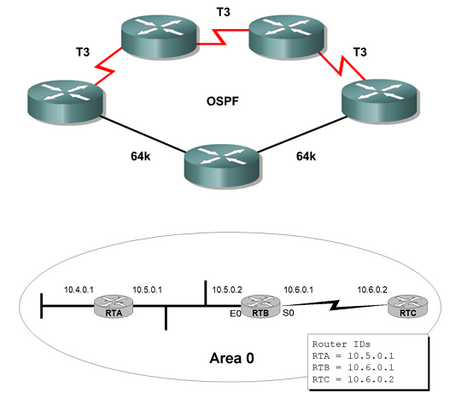Welcome to CCNP Tutorials. The objective of these tutorials is to provide an in-depth understanding of CCNP.
In addition to free CCNP Tutorials, we will cover common interview questions, issues, and how to’s of CCNP.
Cisco Certified Network Professional (CCNP) is an intermediate-level certification in the Cisco certified professional program. This certification is aimed at full-time network or system administrators, or those who work with local and/or wide-area network (LAN/WAN)infrastructure.
Link: Interface on a router
Link state: Description of an interface and of its relationship to its neighboring routers, including:

-Router ID – Used to identify the routers in the OSPF network
-IP address configured with the OSPF router-id command (extra)
-Highest loopback address (configuration coming)
-Highest active IP address (any IP address)
-Loopback address has the advantage of never going down, thus diminishing the possibility of having to re-establish adjacencies. (more in a moment)

-All routers will be configured in a single area, the convention is to use area 0
-If OSPF has more than one area, it must have an area of 0
-CCNP includes Multi-Area OSPF
-We will include a brief introduction to Multi-Area OSPF so you can see the real advantages of using OSPF
Inclined to build a profession as CCNP Developer? Then here is the blog post on, explore CCNP Training

Example: “Hi, I’m RouterA, and I can reach RouterB via a T1 link and I can reach RouterC via an Ethernet link.”
Each router collects all of this link-state information from other routers and puts it into a topological database.
Using this information, the routers can recreate a topology graph of the network.
Believe it or not, this is actually a very simple algorithm and we highly suggest you look at it sometime, or even better, take a class on algorithms. (Radia Perlman’s book, Interconnections, has a very nice example of how to build this graph – she is one of the contributors to the SPF and Spanning-Tree algorithms.
This algorithm creates an SPF tree, with the router making itself the root of the tree and the other routers and links to those routers, the various branches.
Using this information, the router creates a routing table.
-process-id: 1 - 65,535
-Cisco feature, which allows you to run multiple, different OSPF routing processes on the same router. (But don’t!)
-Process-id is locally significant and does not have to be the same number on other routers (they don’t care).
-This is different than the process-id used for IGRP and EIGRP which must be the same on all routers sharing routing information.
-Extra: FYI - Cisco IOS limits the number of dynamic routing processes to 30. This is because it limits the number of protocol descriptors to 32, using one for connected route sources, one for static route sources, and 30 for dynamic route sources.
Rtr(config)# router ospf process-id Rtr(config-router)# network address wildcard-mask area area-id
Rtr(config-if)#ip add 10.5.1.1 255.255.255.0 Rtr(config)# router ospf 10 Rtr(config-router)#network 10.5.1.0 0.0.0.255 area 0


The first three octets of the address must match 192.168.3.0 0.0.0.3

Rtr(config)# interface loopback 0 Rtr(config-if)# ip add 10.1.1.1 255.255.255.0
-IP address configured with the Router-ID command (extra)
-Highest loopback address
-Highest active IP address

Rtr(config)# interface fastethernet 0 Rtr(config-if)# ip ospf priority <0-255>
The higher priority becomes DR/BDR
Default = 1
Ineligible to become DR/BDR = 0
Rtr(config-if)# bandwidth 64 = Rtr(config-if)# ip ospf cost 1562bandwidth command
Rtr(config-if)# bandwidth kilobits
(ex: 64 = 64,000bps)
ip ospf cost command
RTB(config-if)# ip ospf cost value
(ex: 1562, same as bandwidth = 64kbps)
You liked the article?
Like: 0
Vote for difficulty
Current difficulty (Avg): Medium

TekSlate is the best online training provider in delivering world-class IT skills to individuals and corporates from all parts of the globe. We are proven experts in accumulating every need of an IT skills upgrade aspirant and have delivered excellent services. We aim to bring you all the essentials to learn and master new technologies in the market with our articles, blogs, and videos. Build your career success with us, enhancing most in-demand skills in the market.